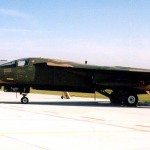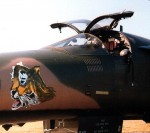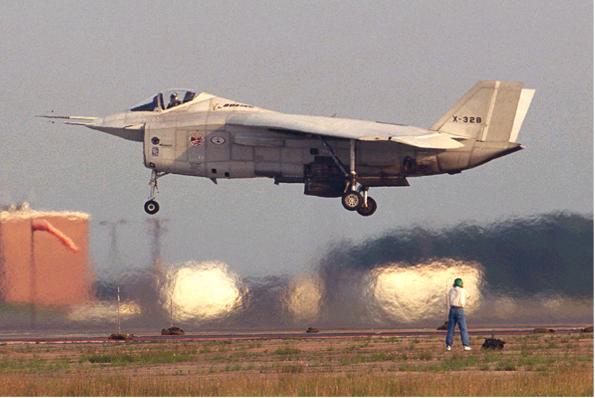
The F-111 was developed according to a US Air Force requirement for a new fighter-bomber and the US Navy’s need for a new air Defence fighter with a single platform. The US navy cancelled the F-111B in 1968 due to overweight.
The F-111 was the first operational aircraft with features like swing wings, and afterburning turbofans, and it could cruise supersonically without using the afterburner in clean setup. It also had terrain following radar and a cockpit escape capsule.
At first some problems were experienced with the swing wing mechanism and the air inlets, but they were resolved eventually.
- F-111A first model.
- F-111E with revised air inlets.
- F-111D included digital avionics.
- F-111F fitted with more powerful engines and improved analog avionics
- FB-111 strategic nuclear bomber with longer wingspan and heavier undercarriage, in the early 1990’s the FB-111’s had their nuclear role removed, and were redesignated the F-111G (they went through a digital avionics upgrade)
F-111F Gulf War veteran (with upgraded digital avionics and pave tack laser designator) was retired in July 1996 While the EW EF-111 Raven jammer bowed was fazed out in 1998.
Australia operates 22 F-111C’s the C combined the engines and avionics of the F-111A with the FB-111B’s heavier undercarriage and longer span wings. Four were modified as RF-111C reconnaissance aircraft, with a similar equipment fit in the bomb-bay as in the F-14’s TARP pod. The F-111C’s carry the Pave Tack pod and the R/F-111C fleet underwent a comprehensive digital avionics upgrade program, completed in 1999. They were re-engined with 93.4 kN TF30-P109’s (from retired USAF F-111’s) in the late 1990’s Australia bought 15 ex USAF F-111G’s which were delivered from 1993. They will help to extend the RAAF F-111 fleet life to 2020.
General characteristics
- Crew: 2 (pilot and weapons system operator)
- Length: 22.4 m (73 ft 6 in)
- Wingspan:
- Spread: 19.2 m (63 ft)
- Swept: 9.75 m (32 ft)
- Height: 5.22 m (17.13 ft)
- Wing area:
- Spread: 61.07 sq m (657.4 sq ft)
- Swept: (48.77 sq m (525 sq ft)
- Empty weight: 21,400 kg (47,200 lb)
- Loaded weight: 37,600 kg (82,800 lb)
- Max takeoff weight: 45,300 kg (100,000 lb)
- Powerplant: 2× Pratt & Whitney TF30-P-100 turbofans
- Dry thrust: 17,900 lbf (79.6 kN) each
- Thrust with afterburner: 25,100 lbf (112 kN) each
- Zero-lift drag coefficient: 0.0186
- Drag area: 0.87 sq m (9.36 sq ft)
- Aspect ratio: spread: 7.56, swept: 1.95
Performance
- Maximum speed: (2,655 km/h (Mach 2.5 1,650 mph)
- Combat radius: 2,140 km (1,330 mi 1,160 nmi)
- Ferry range: 6,760 km (4,200 mi 3,700 nmi)
- Service ceiling: 20,100 m (66,000 ft )
- Rate of climb: 131.5 m/s (25,890 ft/min)
- Wing loading:
-
- Spread: 615.2 kg/sq m (126.0 lb/sq ft)
- Swept: 771 kg/sq m (158 lb/sq ft)
- Thrust/weight: 0.61
- Lift-to-drag ratio: 15.8
Armament
- Guns: 1× M61 Vulcan 20 mm (0.787 in) gatling cannon (seldom fitted)
- Hardpoints: 9 in total (8× under-wing, 1× under-fuselage between engines)
- Armament capacity: 31,500 lb (14,300 kg) ordnance mounted externally on hardpoints and internally in fuselage weapons bay
- Bombs:
- Free-fall general-purpose bombs
- Mk 82 (500 lb/227 kg)
- Mk 83 (1,000 lb/454 kg)
- Mk 84 (2,000 lb/907 kg)
- Mk 117 (750 lb/340 kg)
- Cluster bombs
- BLU-109 (2,000 lb/907 kg) hardened penetration bomb
- Paveway laser-guided bombs, including:
- GBU-10 (2,000 lb/907 kg)
- GBU-12 (500 lb/227 kg)
- GBU-28, specialized 4,800 lb (2,200 kg) penetration bomb
- BLU-107 Durandal runway-cratering bomb
- GBU-15 electro-optical bomb
- AGM-130 stand-off bomb







Be the first to comment